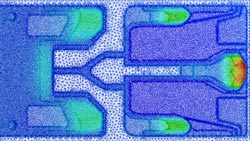Data storage: Better hard drives ready for lift-off

The triangular mesh used to model the properties of a hard disk read/write head. The colors represent the pressure profile of the head; red indicates areas of high pressure.<br><br>© 2013 A*STAR Data Storage Institute<br>
Operating a hard disk drive is as complex as keeping a superfast car on the road. Read/write heads within the hard disk must process a huge amount of data at high speed. Controlling the motion of the slider housing these heads is crucial: if the slider crashes, it could destroy the hard disk.
Researchers at the A*STAR Data Storage Institute (DSI) in Singapore have now developed a computational algorithm for studying the properties of the slider in a hard drive that is faster than existing algorithms1. Instead of taking days to finish, dynamic simulations using the new algorithm take only an hour, notes Wei Hua from the research team. “It greatly improves our simulation and research abilities,” he adds.
A read head typically moves across the disk surface of a hard drive at more than 7,000 revolutions per minute. The flying height of this fast-moving head is as low as 2 nanometers from the surface of the disk, some 50,000 times less than the width of a human hair. Controlling this motion is not easy, notes Hua. “The slider housing the read/write head flies on the fast-rotating hard drive disk, owing to a very thin layer of air. This air bearing pushes the slider upward, while a suspension bearing pushes the slider down toward the disk.”
Thermal effects control the distance of the head to the surface when it is being pushed down. To understand these effects, and other factors that control disk and head movements at high speed, fine-grained computer simulations are necessary.
Hua and co-workers expanded the DSI’s ABSolution air bearing simulation software for faster and more precise modeling. Instead of dividing the hard drive slider into a structured rectangular mesh typically used to aid calculations, the researchers used an unstructured triangular mesh that accurately captures the geometry of the read/write head (see image). Moreover, the algorithm better implements the dynamic effects that occur in drive heads, meaning that overall the code works faster and more efficiently.
This modeling software should prove useful in the future development of drive heads, Hua notes. Modeling the interaction between the slider and the rest of the drive is also important. “Influences such as those from the air suspension and disk effects are now being considered,” he explains. Hua and co-workers will use the improved algorithm to model slider properties that were almost impossible to simulate using the previous versions.
The A*STAR-affiliated researchers contributing to this research are from the Data Storage Institute
Journal information
Hua, W., Yu, S., Zhou, W. & Myo, K. S. A fast implicit algorithm for time-dependent dynamic simulations of air bearing sliders. Journal of Tribology 134, 031901 (2012).
Media Contact
All latest news from the category: Information Technology
Here you can find a summary of innovations in the fields of information and data processing and up-to-date developments on IT equipment and hardware.
This area covers topics such as IT services, IT architectures, IT management and telecommunications.
Newest articles

Bringing bio-inspired robots to life
Nebraska researcher Eric Markvicka gets NSF CAREER Award to pursue manufacture of novel materials for soft robotics and stretchable electronics. Engineers are increasingly eager to develop robots that mimic the…

Bella moths use poison to attract mates
Scientists are closer to finding out how. Pyrrolizidine alkaloids are as bitter and toxic as they are hard to pronounce. They’re produced by several different types of plants and are…

AI tool creates ‘synthetic’ images of cells
…for enhanced microscopy analysis. Observing individual cells through microscopes can reveal a range of important cell biological phenomena that frequently play a role in human diseases, but the process of…





















